Intel Core i7-11700K Review: Blasting Off with Rocket Lake
by Dr. Ian Cutress on March 5, 2021 4:30 PM EST- Posted in
- CPUs
- Intel
- 14nm
- Xe-LP
- Rocket Lake
- Cypress Cove
- i7-11700K
Gaming Tests: Final Fantasy XV
Upon arriving to PC, Final Fantasy XV: Windows Edition was given a graphical overhaul as it was ported over from console. As a fantasy RPG with a long history, the fruits of Square-Enix’s successful partnership with NVIDIA are on display. The game uses the internal Luminous Engine, and as with other Final Fantasy games, pushes the imagination of what we can do with the hardware underneath us. To that end, FFXV was one of the first games to promote the use of ‘video game landscape photography’, due in part to the extensive detail even at long range but also with the integration of NVIDIA’s Ansel software, that allowed for super-resolution imagery and post-processing effects to be applied.
In preparation for the launch of the game, Square Enix opted to release a standalone benchmark. Using the Final Fantasy XV standalone benchmark gives us a lengthy standardized sequence to record, although it should be noted that its heavy use of NVIDIA technology means that the Maximum setting has problems - it renders items off screen. To get around this, we use the standard preset which does not have these issues. We use the following settings:
- 720p Standard, 1080p Standard, 4K Standard, 8K Standard
For automation, the title accepts command line inputs for both resolution and settings, and then auto-quits when finished. As with the other benchmarks, we do as many runs until 10 minutes per resolution/setting combination has passed, and then take averages. Realistically, because of the length of this test, this equates to two runs per setting.
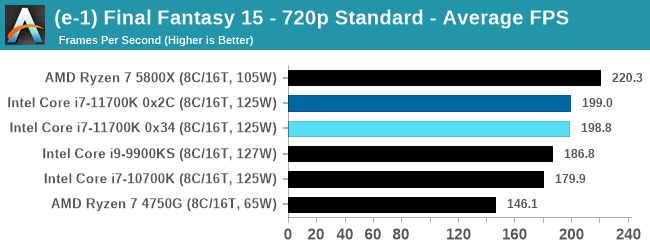
| AnandTech | Low Resolution Low Quality |
Medium Resolution Low Quality |
High Resolution Low Quality |
Medium Resolution Max Quality |
| Average FPS |  |
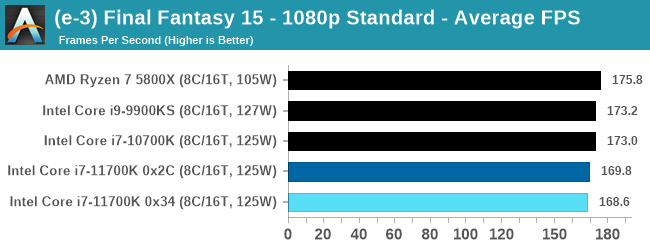 |
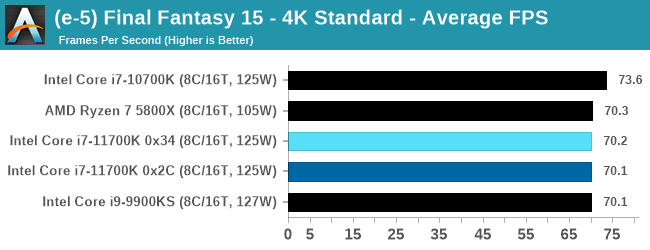 |
 |
| 95th Percentile | 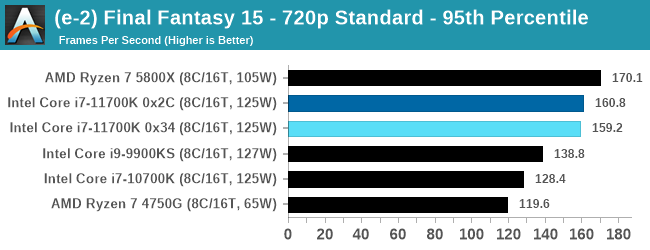 |
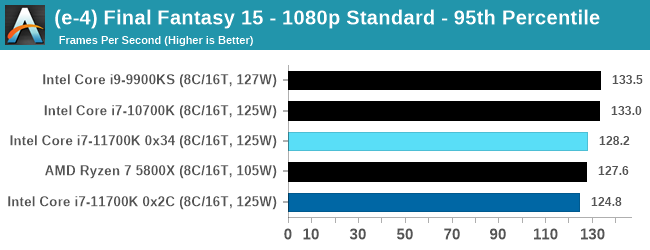 |
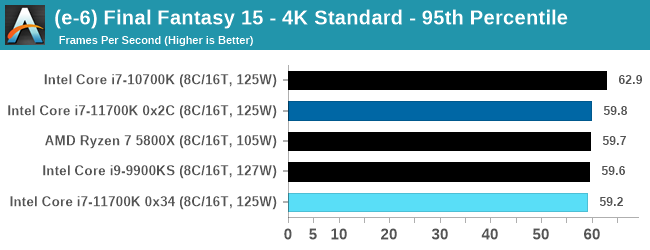 |
 |
In more CPU limited scenarios, the 11700K shows generational improvements over other Intel processors, but as the resolution or quality increases, we end up being GPU limited and all the CPUs even out.
All of our benchmark results can also be found in our benchmark engine, Bench.











541 Comments
View All Comments
Geef - Tuesday, March 9, 2021 - link
What, you don't?Hifihedgehog - Saturday, March 6, 2021 - link
I predicted ~300W peak power about a year or so ago when I first heard they were making the big mistake of bringing AVX-512 to mainstream consumer processors. Why on earth? There was a valid, wise, very, very, very good reason Intel had reserved AVX-512 to just their 14-nm HEDT processors and that had always been the furnace-like heat and nuclear-like power consumption of it. Even with the best logical design improvements from a new microarchitecture, it is still an extremely intensive logical pill of a task to swallow. Now, we see that reason in full, unadulterated display. You bring a massively complex instruction set extension to a higher process node where you have far lengthier physical networks (meaning essentially longer wires, increased resistance, higher power, and maximum heat) and, of course, you are going to have a steaming pile. Remember this review is only looking at the number two product, the Core i7-11700K which has lower clocks and lower power draw. The Core i9-11900K will likely need a 360- or 420-mm AIO just to not thermal throttle like mad. My 5950X with its meager 240mm AIO (Corsair H100i RGB Platinum) that runs at the quiet mode setting is laughing its butt off right about now. When Ian Cutress had to use an obnoxiously loud 170 CFM fan (I have used 100 CFM Deltas and those already annoy most PC enthusiasts) on a massive 4-pound, full copper heatsink to tame the 11700K's 290W, I shudder to think. Will the 11900K be outdoing the FX-9590's record-making peak power draw of 350W (see here: https://www.anandtech.com/show/8316/amds-5-ghz-tur... ? Ian easily could have gotten the 11900K also at retail, but I think he is holding back on that because he already knows the 11900K is going to be a throttling disaster and only the 11700K is an ACTUALLY USABLE PROCESSOR. *mike drop*Hifihedgehog - Saturday, March 6, 2021 - link
I am referring to 14nm mainstream consumer processors if that wasn't abundantly clear.Santoval - Saturday, March 6, 2021 - link
"To be clear, I was replying to you to get a reply at the top of the comments".You got me.. :)
Samus - Saturday, March 6, 2021 - link
In all fairness, it's actually amazing what Intel has achieved here with, essentially, a 6 year old manufacturing process!Spunjji - Monday, March 8, 2021 - link
Are we reading the same review? It looks like they *regressed* in performance vs their 5.5-year-old architecture on the same process.dihartnell - Thursday, March 11, 2021 - link
I think they did they realistically could given the contraints they have. We are not going to see intels true potential until they get thier manufacturing process fixed or they swallow the dead rat and go to another foundry. This will be enough to keep them in the game for another year.Hifihedgehog - Friday, March 5, 2021 - link
Summary image:https://i.redd.it/4i2eu882qbl61.png
tl;dr: Worse in games, moderately better in synthetics, slower and far more power hungry than Ryzen 5000
Bik - Saturday, March 6, 2021 - link
ThanksGondalf - Saturday, March 6, 2021 - link
Main defect of the article: AMD best of the best (low availability) versus a common high volume medium level Intel SKU.No matter the price that will change on retails or OEMS.
I don't understand AMD, they pump hard the pedal still they can not do much to gain market share. New processes are medium volume and with too much customers.
The NEW AMD will be a company capable to deliver a pile of good dies to all channels, without limitation on volume. Unfortunately Lisa follow the wrong street, in this manner Intel will always dominate the market.
Bet 2021 will be Lisa last year at AMD.